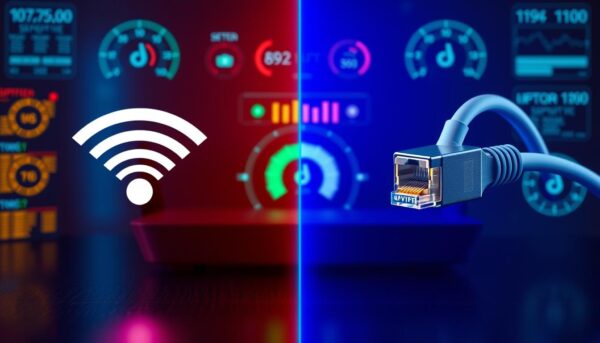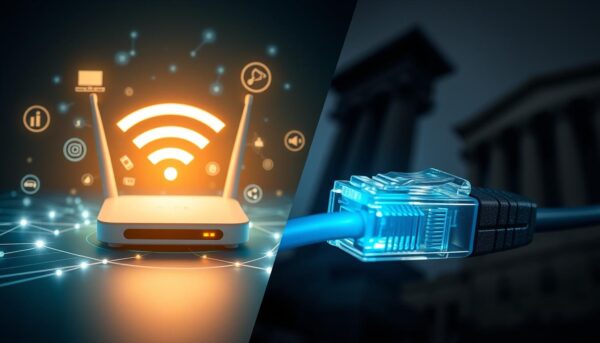✅ Last checked on
Ever thought if your internet is really as good as it could be? Choosing between WiFi and Ethernet can change your online life a lot. It doesn’t matter if you just surf the web, play games, or work from home. Knowing the good and bad of wireless and wired networks is key to a better digital life.
In today’s world, the WiFi vs Ethernet debate is big. WiFi lets you connect without cables, but Ethernet is faster and more reliable. So, which one is best for you? Let’s explore network options and find out what’s best for your WiFi Ethernet choice.
Key Takeaways
- Ethernet offers faster speeds, up to 10 Gbps with latest standards
- WiFi provides mobility and convenience for multiple devices
- Wired connections have lower latency, ideal for gaming and video calls
- Ethernet is more reliable with near-zero dropout rates
- WiFi 6 and upcoming WiFi 7 are closing the performance gap
- Your choice depends on specific needs: speed vs. flexibility
Understanding the Basics of Network Connectivity
Network connectivity is key for home networking and internet access. We’ll look at WiFi and Ethernet connections.
What is WiFi and How Does It Work
WiFi sends data wirelessly using radio waves. It’s popular for home networks because it’s easy to use. WiFi 6 can reach speeds of 9.6 Gbps, but real speeds are about 1.3 Gbps.
What is Ethernet and Its Core Principles
Ethernet uses cables to connect devices. It’s fast, with speeds over 10 Gbps. It’s great for gaming and streaming because it’s stable and has low latency.
The Evolution of Network Technologies
WiFi and Ethernet have both improved a lot. WiFi now has better security with WPA3. Ethernet cables have gotten faster, from Cat5 to Cat6, and can send data up to 1 Gbps over 300 feet.
| Feature | WiFi | Ethernet |
|---|---|---|
| Max Speed | 9.6 Gbps (theoretical) | 10+ Gbps |
| Typical Range | 30-50 meters | Up to 100 meters |
| Latency | Higher | Lower |
| Interference | Prone to interference | Minimal interference |
Knowing these basics helps you choose the best setup for your home network and internet.
Speed and Performance Comparison
When it comes to network performance, WiFi and Ethernet are in a fierce battle. Let’s look at the numbers and see who comes out on top.
Maximum Speed Capabilities
Ethernet cables have a clear speed advantage over WiFi. Here are the max speeds:
| Connection Type | Maximum Speed |
|---|---|
| Cat5e Ethernet | 1 Gbps |
| Cat6a Ethernet | 10 Gbps |
| WiFi 6 | 9.6 Gbps |
Real-world Performance Testing
In real life, Ethernet’s lead is even more pronounced. Ethernet download speeds reach 395 Mbps, close to paid speeds. WiFi, on the other hand, lags at 126 Mbps.
For gaming, Ethernet’s lower latency (16 ms ping) is a big win over WiFi’s 60 ms. This is key for smooth gaming.

Factors Affecting Connection Speed
Many factors influence your actual speeds. WiFi struggles with obstacles and distance, while Ethernet remains steady. Bandwidth needs also vary.
Small homes need about 578 Mbps, while larger ones require 800+ Mbps. Choose your connection based on your needs and setup.
Ethernet connections are generally less prone to interference and have lower latency compared to Wi-Fi connections.
Making Your WiFi Ethernet Choice
Choosing between WiFi and Ethernet for your home network depends on several factors. Your choice affects your network setup and how you connect. Let’s look at important points to help you decide.
Think about how you use your devices. Desktops and smart TVs work well with Ethernet. Mobile devices, like phones and laptops, are better with WiFi for ease of use.
Speed is key. Ethernet gives you faster and more stable connections. A CAT 6 Ethernet cable can reach speeds of 940 Mbps over 328 feet. WiFi speeds, on the other hand, depend on the signal and nearby interference.
For gaming and streaming, Ethernet is usually better than WiFi. Gaming benefits from Ethernet’s reliability, helping avoid network slowdowns.
| Connection Type | Max Speed | Typical Real-World Speed | Best For |
|---|---|---|---|
| Ethernet (CAT 6) | 1 Gbps | 940 Mbps | Gaming, Large File Transfers |
| WiFi 6 | 9.6 Gbps | 1.6 Gbps | Mobile Devices, Smart Home |
Think about what you need when choosing between WiFi and Ethernet. Ethernet is great for tasks that need a lot of bandwidth. WiFi is better for everyday use and mobile devices. Your network should meet your specific needs, balancing speed and convenience.
Security and Reliability Considerations
When picking between WiFi and Ethernet, security and reliability are key. These factors greatly impact your network’s performance. Let’s explore what makes your connection safe and stable.
Network Security Risks and Protection
WiFi routers face more security threats than Ethernet cables. Wireless networks can be hacked through password cracking or signal tapping. To keep your WiFi safe:
- Use WPA2 or WPA3 encryption
- Set up a separate guest network
- Regularly update your router’s firmware
Ethernet connections are more secure because they’re physical. This makes it harder for unauthorized access without direct cable access.
Connection Stability Analysis
Ethernet cables are more stable than WiFi. A CAT 6 cable can support speeds up to 1 Gbps over 328 feet. In real-world use, it reaches speeds around 940 Mbps. WiFi speeds, on the other hand, can drop due to interference and congestion.

Interference and Signal Quality
WiFi performance drops with distance and physical barriers. Ethernet cables, being immune to these issues, offer consistent speeds and lower latency. This makes Ethernet perfect for gaming and high-demand activities where stability is crucial.
“Ethernet connections typically provide a stable, lag-free experience preferred by gamers, ensuring consistency in speed and performance.”
Think about your specific needs when deciding between WiFi and Ethernet. For top security and stability, Ethernet is the better choice. But if you value flexibility, a well-secured WiFi network can still meet most users’ needs.
Cost and Installation Requirements
Setting up your network infrastructure means choosing between WiFi routers and Ethernet cables. Let’s look at the costs and how to install each.
WiFi setups are often cheaper at first. A good WiFi router costs between $80 and $120. It’s easy to set up, taking just a few minutes. For bigger homes, WiFi extenders might be needed, adding $45 to $100 to the cost.
Ethernet installations are more expensive but offer long-term benefits. A professional Ethernet setup can cost $416 on average. Homeowners usually spend between $186 and $675. This includes both labor and materials. Ethernet cables cost between $0.06 and $4.60 per foot, depending on the quality.
For a full Ethernet network, expect to spend more. Installing 2,000 feet of cable with eight connections can cost $3,800. This includes about 30-40 hours of work at $50-$130 per hour. The cost of materials depends on the cable type:
- CAT 5: $0.55-$1.10 per foot (up to 100 Mbps)
- CAT 6: $0.90-$1.55 per foot (10 Gbps up to 55 meters)
- CAT 7: $1.35-$2.10 per foot (10 Gbps up to 100 meters)
Ethernet installation is more expensive but offers faster and more reliable connections. WiFi is flexible but might need upgrades or extenders sometimes. Your choice depends on your home, budget, and what you need for performance.
| Feature | WiFi | Ethernet |
|---|---|---|
| Initial Cost | $80-$220 | $186-$675 |
| Installation Complexity | Low | High |
| Speed Potential | Up to 9,600 Mbps | Up to 10,000 Mbps |
| Long-term Reliability | Moderate | High |
Gaming and Streaming Applications
Network performance is key for gaming and streaming. Let’s explore how WiFi and Ethernet compare for these high-demand activities.
Latency and Gaming Performance
Latency is crucial in online gaming. Ethernet leads with a latency of 1 to 5 milliseconds. This low lag gives gamers an edge in fast games. WiFi, with a latency of 10 to 50 milliseconds, can be a disadvantage in quick games.
Streaming Quality and Buffering
For smooth streaming, bandwidth is essential. Ethernet can transfer data at speeds up to 5 Gbps, preventing buffering. WiFi 6 can reach 9.6 Gbps, but real speeds are often lower. In homes with many devices, WiFi bandwidth can be split, leading to quality drops.
Professional Gaming Requirements
Pro gamers prefer Ethernet for its reliability. Wired connections avoid interference, keeping performance stable in busy networks. This stability is critical for competitive gaming, where every second matters.
| Feature | Ethernet | WiFi |
|---|---|---|
| Latency | 1-5 ms | 10-50 ms |
| Max Speed | 5 Gbps | 9.6 Gbps (theoretical) |
| Stability | High | Variable |
| Interference | None | Susceptible |
While WiFi is flexible, serious gamers and streamers should opt for Ethernet for better performance. Your choice depends on your specific needs and setup.
Future-Proofing Your Network Setup
As technology keeps getting better, it’s key to plan for your network’s future. We’ll look at how to make a system that grows with you, now and later.
Emerging Network Technologies
Wireless networking is moving fast. Wi-Fi 7 could reach speeds of 46 Gbps, handling more devices smoothly. For wired, Cat6 cables can go up to 10 Gbps over 328 feet, great for most homes.
Infrastructure Considerations
Think ahead when setting up your network. For a 90m² apartment, start with one U6 Long Range AP. You might need 1-2 more later. Use Cat6 wiring everywhere and think about fiber for longer runs.
Also, add 4 more Ethernet drops for future devices or security cameras.
Scalability Options
To make sure your setup can grow, consider these:
- Use Cat6a cables for 10-15 years
- Install fiber cables where you can – they’re often cheaper than Cat6a
- Choose UniFi Wi-Fi 7 access points for great coverage and monitoring
- Plan AP placement to avoid dead zones, important in complex homes
With these steps, you’ll have a network that can keep up with new tech and your changing needs.
Conclusion
Your choice between WiFi and Ethernet is key for a better home network. Each has its own strengths, but pick what fits your needs best.
Ethernet is great for speed and reliability. It can reach speeds of up to 10,000 Mbps with Cat6 cables. This beats WiFi’s top speed of 866.7 Mbps.
For gamers and streamers, Ethernet is a big win. It cuts down on lag by up to 50%. This means smoother 4K streaming and faster online gaming.
WiFi, though, is all about convenience and mobility. It’s perfect for homes with lots of devices. It supports many connections at once without needing extra ports.
WiFi speeds can change based on distance and interference. Still, most U.S. users get speeds of 80-120 Mbps.
Think about mixing both for the best network. Use Ethernet for devices that need top performance. Use WiFi for gadgets you move around with. This way, you get the best of both worlds.